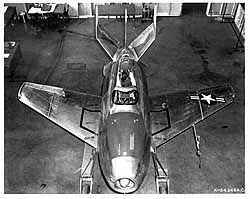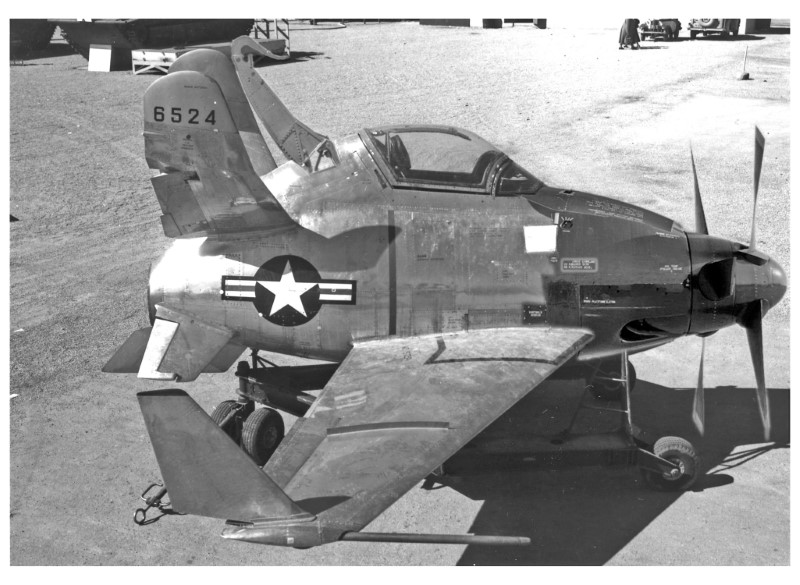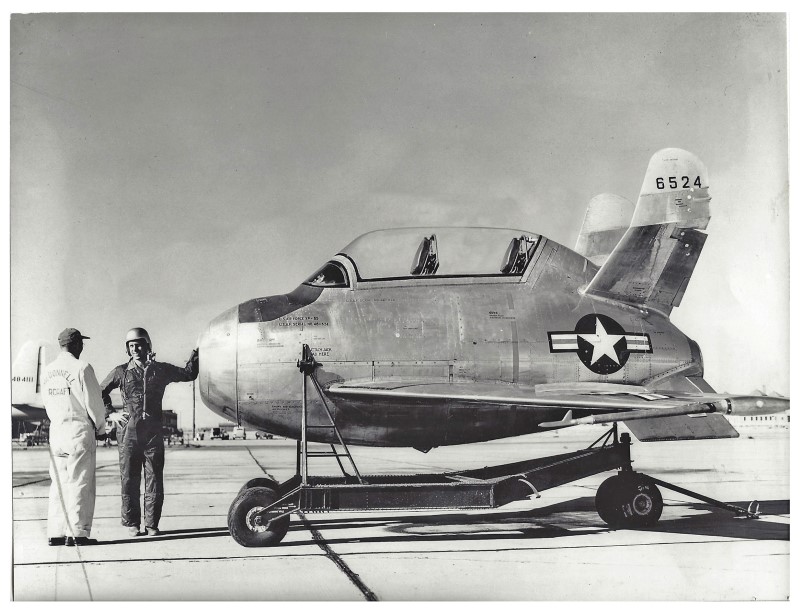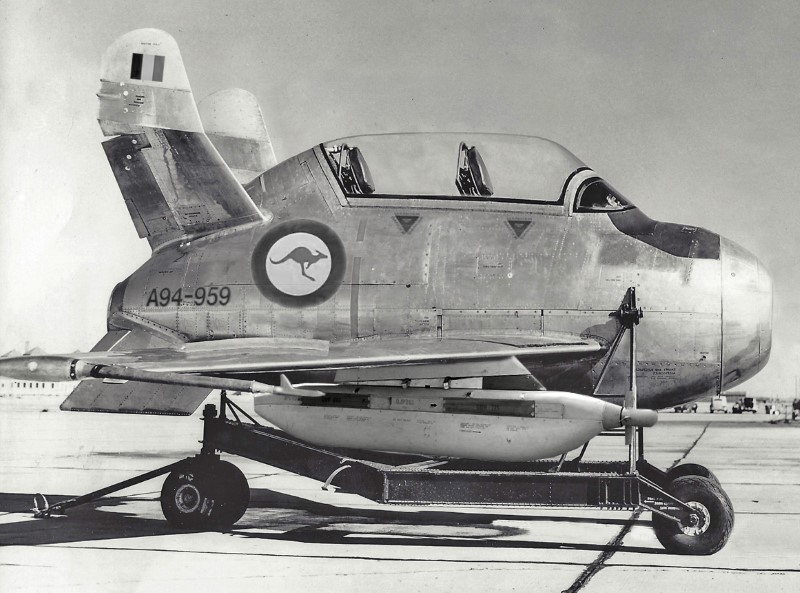
|
«Goblinography» - a Goblin bibliography in a PDF file with links to this website and to the original sources of information «Goblinography» - una bibliografia sul Goblin in un file PDF con link a questo sito Web e alle sorgenti originali delle informazioni (testo in inglese) |
|
INDEX OF THIS PAGE (but don't forget the Menu!) INDICE DI QUESTA PAGINA (ma non scordatevi il Menu!) |
||
Menu |
Wikipedia |
Credits |
Foreword |
Pictures from the collection |
XF-85 in Video |
Documents and Image Credits
- Diritti sulle Immagini e sui DocumentiIn recent years, the hugest work of information collection about the Goblin was made by Ron Downey, a retired Aeronautical Engineer who worked for McDonnell Aircraft and McDonnell Douglas Corporation for 40 years, in a 2015 post on his "Aviation Archives" blog (http://aviationarchives.blogspot.com/2015/04/). I discovered his work in May 2019 during a search for NACA Research Memorandums (most of which are available on the NTRS - NASA Technical Reports Server), and I added a whole image gallery based on his excellent work of photographic collection and selection.
The PDF file containing the article by Dick Powers, from the Fall 1973 issue of Journal of the American Aircraft Historical Society, was recovered from this URL. At some time in the early 1980's I obtained a preliminary version of the same article from the Edwards AFB History Office thanks to Richard Hallion, together with the XF-85 Pilot Handbook. The pictures included in the text where recovered from the PDF file cited above, that is also included here. Before a manual revision of the text, OCR was performed online thanks to https://www.onlineocr.net/ service. The organizations, institutions and companies cited here are the sole owners of any copyright on the other pictures and documents, that I digitized by flatbed scanner. Raymond Schoch kindly provided many pictures about his father, in the page dedicated to Edwin Schoch. If you decide to re-publish the pictures in this website, please include a link to this page or include the whole "Image Credits" section appearing here.
Negli ultimi anni, il più significativo lavoro di raccolta di informazioni sul Goblin è stato fatto da Ron Downey, Ingegnere Aeronautico in pensione che ha lavorato per la McDonnell Aircraft e per la McDonnell Douglas Corporation per quarant'anni, in un post del 2015 sul suo blog "Aviation Archives" (http://aviationarchives.blogspot.com/2015/04/). Ho scoperto il suo lavoro nel Maggio 2019 durante una ricerca dei Research Memorandum della NACA (la maggior parte dei quali è disponibile sul NTRS - NASA Technical Reports Server), e ho aggiunto un'intera galleria di immagini basata sul suo eccellente lavoro di raccolta e selezione di fotografie.
Il file PDF contenente l'articolo di Dick Powers, dal numero dell'Autunno 1973 del Journal of the American Aircraft Historical Society, qui tradotto in italiano, è stato recuperato da questo URL. In un qualche momento nei primi Anni Ottanta ho ottenuto una versione preliminare dello stesso articolo dall'ufficio storico della Edwards AFB History Office grazie a Richard Hallion, assieme al Manuale di Pilotaggio dell'XF-85. Le immagini incluse nel testo sono state recuperate del file PDF sopra citato, anche esso incluso qui. Prima di una revisione manuale del testo, è stato svolto un riconoscimento OCR online grazie al servizio https://www.onlineocr.net/. Le organizzazioni, istituzioni e aziende citate qui sono i soli proprietari di tutti i diritti sulle altre immagini e documenti, che ho digitalizzato con uno scanner piano. Raymond Schoch ha gentilmente fornito molte immagini relative a suo padre, nella pagina dedicata a Edwin Schoch. Se decidete di pubblicare nuovamente le immagini di questo sito web, includete un link a questa pagina o includete l'intera sezione "Crediti immagine" che appare qui.
Foreword, by Cesare Brizio
- Premessa, di Cesare BrizioPerhaps no airplane better than the XF-85 can represent the aviation of the first decade after the Second World War, in which the persistence of the classic strategic, tactical and engineering concepts, matured in the conflict just ended, was accompanied by the emergence of new geopolitical scenarios, the maturation of the jet engine, the theorization of nuclear deterrence that would have led to the Cold War, and the need to keep active the military industry, whose collapse could have unpredictable socio-economic repercussions.
To this, with particular reference to the USA, we can add the theoretical contribution of the German aerodynamicists and aeronautical engineers (among other things, also referred to by Dick Powers in note number 3, with reference to the genesis of the Wingtip Coupling program).
The Goblin belongs in the theme of long-range escort, as the first and last fruit of the second generation of dedicated "Parasite Fighters" (after the Sparrowhawks of the Akron and Macon airships, also very present in Powers'article and - among other things - covered by a beautiful article by the National Geographic Magazine in January 1992), considering that the other American efforts of the period (WTC and FICON) used standard fighters with limited modifications.
The long-range escort is in turn the daughter of the already dying concept of strategic bomber, which disappeared shortly after in favor of missile deterrence, but re-emerged briefly during the SEA conflict. Already at the end of the Fifties, it was understood that the Stratofortress would not operate at stratospheric heights, but as carriers of stand-off weapons in below-radar penetrations hundreds of miles from the target.
Here then the Goblin epic boils down to 3.1 million dollars of expenditure (data reported by Knaak) in a climate of skepticism even by those who still supported "classic" strategic bombing. In 1949, a few big brass still seemed to believe in the Goblin: in an excerpt from "Recent Air Force R&D Activities" (Central Air Document Library, June 1, 1949) Gen. Joseph T. McNarney, even considering the three emergency landings already happened at the time, described the Goblin as "Interesting".
But overall, the scenario wasn't promising: to the stinging and fitting observations of Gen. Kenney, textually cited by Dick Powers in his article, we can add those reported by René Francillon about the performance gap between the Goblin and its contemporary interceptors, and those of Marcelle Size Knaak in the first volume of the Encyclopedia of US Air Force Aircraft and Missile Systems: had the bomber been destroyed before launching the fighter, both would be lost. Had the bomber been shot down after launching the fighter, the latter would not have had enough endurance to return home. And, considering that the presence of the parasite fighter implies a disputed airspace, obviously the launch and recovery in combat would be moments of unacceptable vulnerability.
All that considered, the incredible dedication of Ed Schoch, a Test Pilot never adequately celebrated, is even more relevant. To him alone we owe a most unique and rare thing, the survival of both prototypes. The fortunate circumstance that the aircraft were small and curious in appearance made the USAF prefer not to proceed with their dismantling, but to use them, as Powers recalls, in exhibitions, even mobile displays. Now they are both musealized, which can not be said of other extraordinary aircraft of the same era (the great Flying Wings of Northrop, dismantled, or the Republic XF-12 Rainbow ended as an artillery target, to cite only a couple of cases).
It warms my heart to put my hand back today, in 2018, to the research that, together with many others similar endeavors, engaged me between 1980 and 1983, and that I wanted, at the time, to turn into a book. At the time communication was by letter, and some information was still "classified". For example, I asked the American Defense Logistics Agency (DLA) for the characteristics of the AN-F-48a gasoline (I had made up my mind to calculate the efficiency of the Westinghouse J34-WE-22 engine!), but it was the Naval Attaché of the Italian Embassy in Washington to answer me that the DLA, like all the American military institutions, did not release information to foreign firms or citizens.
My request would have been considered only if conveyed by an Italian military organization, and in particular by the National Security Authority. As I feared, that institution was not very sensitive to my requests: I have in my hand a dark envelope of the Ministry of Defense, which I received in May 1983, obviously with 2200 lire mailing expenses charged to me!, which explained that, not being an entity for scientific research, they would not have forwarded any request of mine...
Rather than keeping it in a drawer, I prefer to share much of the material I've collected on this web page: I'm sure it will interest aviation fans.
Forse nessun aeroplano meglio dell'XF-85 può rappresentare l'aviazione della prima decade dopo la Seconda Guerra Mondiale, in cui la persistenza dei classici concetti strategici, tattici e costruttivi, maturati nel conflitto appena concluso, si accompagnava con il delinearsi di nuovi scenari geopolitici, la maturazione del motore a getto, la teorizzazione della deterrenza nucleare che avrebbe portato alla Guerra Fredda, e la necessità di mantenere attivo il comparto dell'industria militare, il cui crollo avrebbe potuto avere ripercussioni socio-economiche imprevedibili.
A questo, con particolare riferimento agli USA, possiamo aggiungere l'apporto teorico degli aerodinamici e degli ingegneri aeronautici Tedeschi (tra l'altro richiamato anche da Dick Powers alla nota numero 3, con riferimento alla genesi del programma WTC). Il Goblin si colloca nel tema della scorta a lungo raggio, come primo e ultimo frutto della seconda generazione dei "Caccia Parassiti" dedicati (dopo gli Sparrowhawk dei dirigibili Akron e Macon, anche essi ben presenti a Powers e tra l'altro oggetto di un bellissimo articolo del National Geographic Magazine nel Gennaio 1992), considerato che gli altri sforzi americani del periodo (WTC e FICON) utilizzavano caccia di serie con limitate modifiche.
La scorta a lungo raggio è a sua volta figlia del già morente concetto di bombardiere strategico, scomparso di lì a poco a favore della deterrenza missilistica, salvo riemergere per breve periodo durante il conflitto del Sud Est Asiatico. Già alla fine degli Anni Cinquanta si era capito che le Stratofortress non avrebbero operato a quote stratosferiche, ma come vettori di armi stand-off in penetrazioni sotto la quota dei radar a centinaia di miglia dal bersaglio.
Ecco che quindi l'epopea del Goblin si traduce in 3,1 milioni di dollari di spesa (dato riportato da Knaak) in un clima di scetticismo anche da parte degli assertori del bombardamento "classico". A 1949 inoltrato, qualche pezzo grosso sembrava ancora confidare nel Goblin: in un estratto da "Recent Air Force R&D Activities" (Central Air Document Library, 1 Giugno 1949) il Gen. Joseph T. McNarney, pur considerando i tre atterraggi d'emergenza avvenuti all'epoca, descriveva il Goblin come "Interessante".
Ma il vento era decisamente contrario: alle pungenti e azzeccate osservazioni del Gen. Kenney, testualmente riportate da Dick Powers nel suo articolo, possiamo aggiungere quelle richimate da René Francillon riguardo al gap di prestazioni rispetto agli intercettori contemporanei al Goblin, e quelle di Marcelle Size Knaak nel primo volume della Encyclopedia of U.S. Air Force Aircraft and Missile Systems: se il bombardiere fosse stato distrutto prima di aver lanciato il caccia, entrambi si sarebbero perduti. Se il bombardiere fosse stato abbattuto dopo aver lanciato il caccia, quest'ultimo non avrebbe avuto autonomia sufficiente per ritornare a casa. E, considerato che la presenza del caccia parassita presuppone uno spazio aereo conteso, ovviamente il lancio e il recupero nel corso del combattimento avrebbero costituito momenti di inaccettabile vulnerabilità.
Tutto ciò considerato, l'incredibile dedizione di Ed Schoch, Pilota Collaudatore non abbastanza celebrato, è ancora più rilevante. A lui solo dobbiamo, cosa più unica che rara, la sopravvivenza di entrambi i prototipi. La fortunata circostanza che i velivoli fossero piccoli e di aspetto curioso ha fatto preferire all'USAF di non procedere al loro smantellamento, ma di impiegarli, come ricorda Powers, in mostre, anche itineranti. Ora sono entrambi musealizzati, il che non si può dire di altri straordinari aerei della stessa epoca (le grandi Ali Volanti di Northrop, smantellate, o il Republic XF-12 Rainbow finito come bersaglio di artiglieria, per citare solo un paio di casi).
Mi scalda il cuore rimettere mano oggi, nel 2018, alla ricerca che, assieme a tante altre, mi impegnò tra il 1980 e il 1983, e che a quel tempo avrei voluto trasformare in un libro. All'epoca si comunicava per lettera, e alcune informazioni erano ancora "classified". Ad esempio, richiesi alla Defense Logistics Agency (DLA) americana le caratteristiche della benzina AN-F-48a (mi ero messo in testa di calcolare l'efficienza del motore Westinghouse J34-WE-22!), ma fu l'Addetto Navale dell'Ambasciata Italiana a Washington a rispondermi che la DLA, come tutti le istituzioni militari americane, non dialogava con ditte o cittadini stranieri.
La mia richiesta sarebbe stata presa in considerazione solo se inoltrata da un'organizzazione militare italiana, e in particolare dall'Autorità Nazionale per la Sicurezza. Come temevo, questa istituzione non fu molto sensibile alle mie istanze: ho qui in mano una busta oscurata del Ministero della Difesa, che ricevetti a Maggio 1983, naturamente con 2200 lire di tassa a mio carico!, in cui mi si spiegava che, non essendo io un ente con finalità di ricerca scientifica, non avrebbero veicolato alcuna richiesta per mio conto...
Piuttosto che tenerlo in un cassetto, preferisco condividere su questa pagina Web buona parte del materiale che ho raccolto: sono sicuro che potrà interessare gli appassionati.
COLLECTION - COLLEZIONE |
|||
Selected pictures from the AAFC collection |
Selezione di immagini dalla collezione AAFC |
||
.jpg) |
.jpg) |
 |
.jpg) |
.jpg) |
.jpg) |
.jpg) |
.jpg) |

(Above) Goblin: What Else? Some jokeful fake pictures
(Sopra) Goblin: Che Altro? Qualche scherzosa immagine falsa

(Above) Another "What if?" - The XF-85C Proplin, with an undersized version of the Allison XT40 engine
(Sopra) Un altro "What if?" - l'XF-85C Proplin, con una versione sottodimensionata del motore Allison XT40

(Above) My penultimate "What if?" - The XF-85T "Twin Goblin"
(Sopra) Il mio penultimo "What if?" - l'XF-85T "Twin Goblin"

(Above) My last "What if?" - The TF-85B "Gotrain"
(Sopra) Il mio ultimo "What if?" - Il TF-85B "Gotrain"

(Above) My very last "What if?" - The electronic warfare EF-85E "Ewlin" of the RAAF, with an AN/ALQ-99 pod
(Sopra) Il mio ultimissimo "What if?" - l' EF-85E "Ewlin" da guerra elettronica della RAAF, con un pod AN/ALQ-99
❦